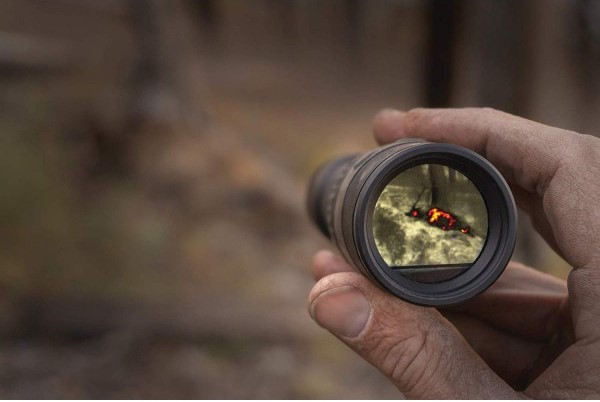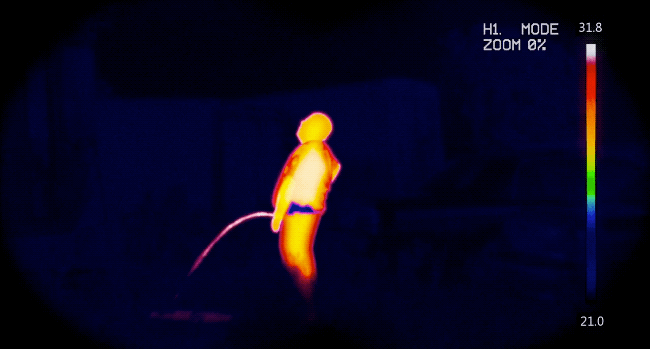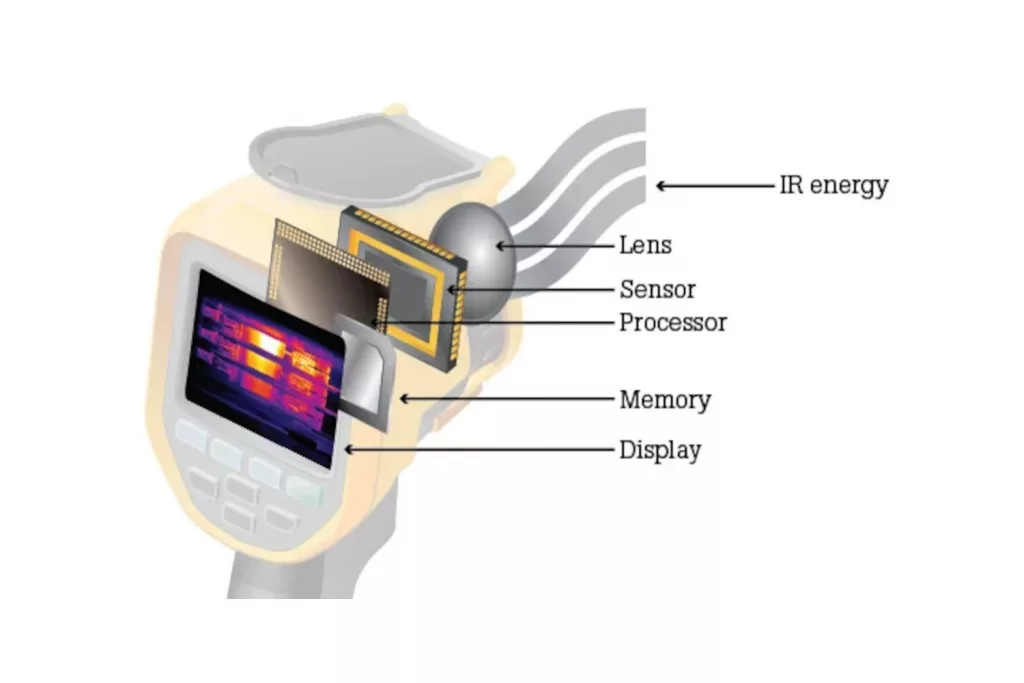
Night vision systems for hunters are all about being ahead of curve!
The same can be true for anyone stalking wildlife, whether for birdwatching, varmint control, or game management. In many instances, a thermal monocular is the best choice.
The problem is finding the best thermal monocular for your individual needs and expectations.
Many manufacturers build thermal monoculars. In general, these brands and models use the same basic technology to produce the same results.
However, not all thermal monoculars are created equal.
Differences in features, quality control, and customer support are also important factors to consider.
Don’t let price alone be your sole consideration.
Sometimes adding a few dollars to the budget to get a better thermal monocular pays off in the long run.
Finding the best thermal monocular for your situation requires some knowledge of how thermal monoculars work and what features are critical, and which are in the nice to have category.
So, in case you’re in a hurry and do not wish to read throughout, below are the shortlisted thermal monoculars you could get today.
Top 5 Best Thermal Monoculars You Can Buy Today:
Last update on 2024-06-30
Why Thermal Monoculars?
If your activities involve nighttime routines where you need to see wildlife, people, or almost anything else clearly and precisely, a thermal monocular is necessary.

You see it All with Thermal!
Thermal monoculars take the concept of night vision a step beyond previous versions. There are many situations where a thermal monocular can be an asset.
- Many varmint nighttime varmint hunters use thermal monoculars to scout for game
- Many biologists and naturalists use thermal monoculars to observe nocturnal animals and birds
- Search and rescue teams routinely use thermal imaging during victim searches
- Fire rescue personal carry thermal imagers to search out hidden fire and hot spots
- Law enforcement uses thermal imaging for enforcement and surveillance operations
These represent only a few of the possible uses of a thermal monocular.
Anywhere a temperature difference is important, thermal monoculars give you an advantage.
The Technology is the Key: How Do Thermal Monoculars Work?
Understanding how older night vision systems work and how thermal imaging works quickly points up the advantages of a thermal monocular.
Typical night visions system gathers existing light using special sensors and amplify that light so you can recognize the images. Light amplification works great with the ambient light of some sort, or you can employ an infrared illuminator.
Thermal imaging technology takes a different approach.

Thermal imagers look not at visible light but the heat signature of your surroundings.
The technology then converts the difference in temperature of your surroundings into a visible image that shows the differences in temperature in different colors.
Thermal imaging does not require ambient light, illuminators, or optical lenses of any kind.
The result is the ability to see clearly and distinctly in the dark under most conditions. In some cases, thermal monoculars are also usable during daylight hours.
What Should I Look for in a Thermal Monocular?
Choosing a thermal monocular can be challenging for someone who has never had the opportunity to use one.
I use a thermal monocular mostly for hunting at night. I tend to choose thermal monoculars based on my needs. You may have different needs that require different solutions.
These are the factors I consider when choosing a thermal monocular:
- Durability – When I am spending anywhere from $1,000 to $3,000 for a piece of equipment I can hold in one hand, I am seriously concerned about the product’s durability. Concerns about durability are especially true of thermal monoculars that depend on sensitive electronic components.
- Resolution – The thermal resolution of a handheld thermal monocular determines the quality of the image you see. In general, I want a thermal imager with a resolution of around 384 x 288. If I can afford the price difference, upgrading to a resolution of 640 x 480 I preferable.
- Range – You can get thermal monoculars that will see as far as 1,000 yards. The image is usually poor, and you can’t distinguish details. You may not be able to tell the difference between a man and a deer. I am not concerned with a thermal monocular that outranges my rifle. I typically shoot a .300 AAC Blackout at night and keep my target distances under 175 yards. Select your range based on your needs and your rifle.
- Magnification – One great advantage of thermal imaging technology is utilizing digital zoom instead of optical zoom. You can buy thermal monoculars with 4-9X digital zoom capabilities. This range of magnification typically does not distort the image.
There are many other features and options available on thermal monoculars.
Video recording, color palette choices, Bluetooth connections, and built-in range finders are just a few of these possible additions.
While these options are fun to work with, remembering that every option brings another possible way for your thermal monocular to fail.
Our Choices of the Best Thermal Monoculars
We looked across the market to find what I consider the best thermal monoculars available. In making my choices, I considered several factors in addition to the things listed above:
- The reputation of the manufacturer
- Warranty
- Comments and experiences of other users
- Price
You may have other priorities that affect what you use to make your decision.
My priorities are hunting and stalking varmints at night.
So here are the best thermal monoculars you could get for hunting coyotes or birding:
Best Overall Thermal Monocular – ATN OTS-HD 384 2-8x, Thermal Monocular
- Thermal Sensor with 384*288 pixel HD resolution - the powerful thermal sensor gives the ability to...
- Smart Rangefinder - thermal monocular accurately measures precise distances to a subject using...
- 3D Gyroscope and E-compass - gyroscopic image stabilization reduces natural hand shake and provides...
Last update on 2024-06-29
I don’t normally recommend products that try to do everything in one package. Getting every feature possible into a single package often involves unacceptable compromises.
However, ATN has created a thermal monocular with almost every possible feature and option without the associated problems.
The ATN OTS-HD 384 thermal imaging monocular is my pick for the best overall thermal imaging monocular.
Looking down at the following features list makes you wonder how ATN manages to get it all in a small package:
- 384 x 288 HD display
- Smart rangefinder
- 3D gyroscope
- Electronic compass
- Electronic zoom 2-8X magnification
- Video recording to SD card
- Still Picture capabilities
- Wi-Fi streaming
- Upgradeable firmware
- Selectable color palette
There isn’t much more anyone could ask for in a thermal imaging scope.
ATN warranties their thermal imaging monoculars to be free from manufacturing and materials defects for two years from when you purchase the monocular.
The Best Thermal Monocular for Coyote or Pig Hunting – Leupold LTO Tracker 2 Thermal Viewer
Last update on 2024-06-29
I am an avid feral pig hunter.
I have a dedicated suppressed rifle fitted with a thermal scope that I use for hunting pigs. I also carry a thermal monocular to scan areas outside the field of view of my scope.
I don’t have to move my rifle once I am in position, which keeps noise minimal.
My choice of thermal imaging monoculars for this task is the Leupold LTO Tracker 2.
The main advantage for me is the small size of this thermal imaging device.
Don’t misunderstand. This thermal imaging monocular from Leupold does everything I need it to do and more.
Here are some of the features that make Leupold LTO Tracker 2 Thermal Viewer, our choice:
- 100% waterproof, fog-proof and shock-resistant
- 240 x 204 resolution display
- 600-yard detection range
- Durable gorilla glass display
- 7x digital zoom
- Electable color palette options
- It weighs only seven ounces
- Usable in the daytime as well as nighttime
- Operates from -40 degrees to +572 degrees Fahrenheit
Leupold is known for the durability and quality of its optical products.
The Leupold LTO Tracker 2 thermal monocular is no exception. Leupold warranties their thermal imaging products for two years.
Best Budget Thermal Imaging Monocular – FLIR Scout TK Pocked-Sized Monocular
- RELIABLE 24/7 VISION - 160 × 120 VOx microbolometer thermal imager reveals humans, animals, and...
- 90-METER DETECTION RANGE - Can detect the heat signature of a human-sized subject from a distance up...
- WATERPROOF - Scout II's rugged, weather-tight shell can be used in the wettest conditions. Tested to...
Last update on 2024-06-29
Many of us are on a budget that keeps us from spending more on a thermal imaging device than on our entire rifle and scope package.
FLIR has come to our rescue with the FLIR Scout TK handheld thermal imaging monocular.
FLIR is a recognized leader in thermal imaging technologies. The FLIR Scout TK line of thermal imaging devices lives up to the FLIR reputation for quality and performance.
You won’t find a FLIR Scout TK lacking in features. Following are some of the features of FLIR Scout Thermal Monocular:
- Pocket-sized for convenient carry
- One-hand use design has only four buttons
- The package includes a neck lanyard, USB cable and lens cap
- Video capture and still picture capture
- 160 x 120 resolution
- Detection range – 100 yards
- Weighs 6 ounces
- Rechargeable battery lasts 5 hours
The FLIR TK Scout is a good option if you want a thermal monocular to take to the field for most hunting or stalking situations and are on a budget.
Yes, the display is rather small, and the range is limited, but you will have the luxury of thermal imaging in a lightweight and durable package.
The Ultimate Thermal Imaging Monocular – Trijicon Electro Optics IR Patrol M250
No products found.
If budget is not an issue and your need the absolute best thermal imaging device available, the Trijicon IR Patrol M250 thermal imaging monocular is the choice.
The Trijicon reputation backs these thermal monoculars ensuring the best performance and durability.
The Trijicon IR Patrol M250 line are professional-grade thermal imaging products suitable for military or law enforcement use.
No products found.
These thermal monoculars will serve anyone well under any circumstances.
Here are some of the features that make Trijicon Electro Optics IR Patrol M250, our choice:
- The most versatile thermal imaging monocular on our list.
- Can be handheld, helmet-mounted, or weapon-mounted
- The Single-button thumbstick control system is easy and intuitive to use.
- Selectable palette options for best use
- 640 x 480 resolution
- Day or night operation
- Video or still picture capture abilities
- Weighs 16 ounces
- 8X digital zoom
- Video out port for sharing images
The Trijicon IR Patrol M250 is no run-of-the-mill thermal imaging monocular.
When you purchase a Trijicon M250, you get a state-of-the-art, professional-grade thermal monocular.
You will also pay the appropriate price for this level of equipment.
The Cheapest Thermal Monocular – AGM Global Vision Asp-Micro TM160 Short Range Thermal Imaging Monocular
- The AGM Asp-Micro TM160 Thermal Imaging Monocular is a handheld device equipped with a 160×120...
- The monocular supports functions such as observation, distance measurement, and highest temperature...
- With its high-sensitivity built-in thermal detector, the Asp-Micro provides clear views even in...
Last update on 2024-06-29
At the bottom of the price list, there are several thermal imaging monoculars.
You may find cheaper thermal monoculars than the AGM TM160 thermal imaging monocular. In my opinion, that is as cheap as you can get and have a reliable thermal monocular from a reputable company.
The AGM TM160 thermal imaging monocular is for short-range use.
It has many features that make it useful in the field but may be better suited to find hot spots or other practical purposes.
The AGM TM160 thermal monocular includes the following specs and features:
- 160 x 120 resolution
- Built-in rechargeable lithium battery
- 7 hours continuous runtime per charge
- Wi-Fi hotspot included
- USB Type-C interface
- Distance to target functions with known height target
- Supports video recording and still picture capture
- Limited 3-year warranty
The downside of the AGM TM160 is its limited range.
Identification of humans is difficult beyond 25 yards. Smaller targets may limit this range significantly. I cannot recommend this handheld thermal monocular for hunting because of the short-range.
However, this thermal monocular can fit the bill for finding hotspots in electrical wiring or appliances and other practical purposes.
Frequently Asked Questions
Can Thermal Scopes See Through Brush?
To a certain extent, thermal imaging devices such as monoculars can see through impediments such as brush or grass. Thermal imaging sensors see heat, not visible light. The sensor does not see through brush or grass. The infrared radiation from your target is visible around the grass or brush, allowing the thermal imaging device to build the target picture.
Thermal imaging monoculars will not work through glass. You may be able to see your target through a window in your hunting blind or vehicle, but your thermal imaging device won’t see the target.
Why are Thermal Imaging Monoculars so Expensive?
The sensors, screens, and electronic components for thermal monoculars are behind the high prices. The sensors are expensive to manufacture. These are precision electronic devices requiring very intensive manufacturing processes.
The other electronic components and the programming that controls the features don’t come cheap. To build a feature-rich thermal monocular that is tough enough to withstand the rigors of hunting is a challenge.
Is It Legal to Own a Thermal Scope or Monocular?
If you are a citizen of the United States, it is legal to own and use a thermal imaging device. However, state, or local regulations may limit which thermal devices you can purchase or use. In addition, federal regulations prohibit taking thermal imaging devices out of the country. You also cannot give such a device to a non-citizen.
Read more about regulations on Thermal Scope usage based on state you’re in, here.
Can I Use my Thermal Monocular During the Daytime?
In a word, yes! Thermal imaging devices don’t see light in the visible spectrum. Consequently, thermal monoculars work just as well in the daytime as they do at night. However, heating from the sun can cause some issues with the sensors. In a very hot environment, some thermal imaging sensors may have trouble detecting the temperature differences that the unit needs to build a sharp image.
Is there a Difference between Infrared and Thermal?
Active infrared imaging systems use a short-wavelength infrared illuminator. The sensors typically only see these short-wavelength infrared rays and don’t detect any other light or radiation.
Thermal imagers are passive devices that don’t require any sort of illuminator. The sensors used in thermal imaging devices see the heat signature that everything radiates naturally and converts those signals to visible light displays on a screen.
Going Thermal – Owning the Night
Night hunting or stalking adds a whole new dimension to your outdoor adventures.
A thermal imaging monocular gives you advantages that are hard to understand until you use them.
I can almost guarantee that you will wonder how you managed without a thermal device once you experience using a thermal imaging scope or monocular.
happy Hunting!









